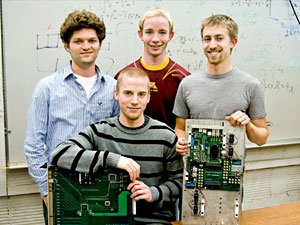Four students help design experiment for world's biggest particle collider

A smashing time
When they walked in the door a few years ago, they didn't know the first thing about how to put together a real-life physics experiment.
But today, from the University of Minnesota's Tate Laboratory, they're working on one of the biggest: the Large Hadron Collider (LHC) in Geneva, Switzerland, designed to recreate the conditions that existed just after the Big Bang.
Quite a transformation for four undergrads, who now find themselves in company with some of the world's top physicists, seeking to learn how our universe came to be and what it consists of.
And their interest in hands-on work delights their adviser, assistant professor.
"One thing I've enjoyed since coming to Minnesota [in 2005] is the quality of undergraduates, especially their level of interest in experimental work," he says. "I was a graduate student and postdoc at Princeton, but most of the students wanted to be string theorists, not experimentalists."
Needle in haystack
The students are helping prepare an experiment at the LHC, which smashes beams of subatomic particles called protons together at nearly the speed of light. The collisions produce sprays of particles; a few might be eagerly sought items like dark matter, believed to account for 80 percent of the universe's mass; or the Higgs boson, thought to endow other particles with mass.
But of the billions of particles born in the collisions, almost all will be junk, not jewels.
"Particle physics is like looking for a needle in a haystack, but the hay straws outnumber the needles by ten trillion [10,000,000,000,000] to one," says senior Nathan Mirman.
He programs and tests a device called the trigger; its job is to decide which few particle "births" are significant and should be recorded for analysis. And it has only 25 nanoseconds between collisions to do it.
One way the trigger tells junk from jewel is to look at the energies of particles produced by a collision, says junior Martin Schroeder.
"If the energy spectrum matches what we're looking for, we keep the data," explains Schroeder, whose forte is laying out and assembling circuit boards to handle the job.
Super opportunity
In a future upgraded LHC experiment, the beams will contain several times the number of protons as today. That prospect generated a project junior Brian Walstrom has just completed.
"I was looking at how good the signal will look under the greatly increased amount of debris," he says.
Also simulating the upgraded experiment is senior Tanner Prestegard, who searches for the best way to tell when collisions have produced electrons. Finding those particles could mean a collision has also produced something interesting, such as a dark matter particle.
Through their work, the students have tasted the thrill of scientific inquiry, and it shows no sign of wearing off. Mirman, Walstrom, and Prestegard have their eye on graduate study in particle or high-energy physics, while Schroeder leans more toward medical school or medical physics. And they all hope someday to visit the LHC and see the behemoth that has occupied them so long.
But most of all, they're unanimous in praising their mentor Mans.
"He's definitely one of the smartest people I've ever met," says Prestegard.
